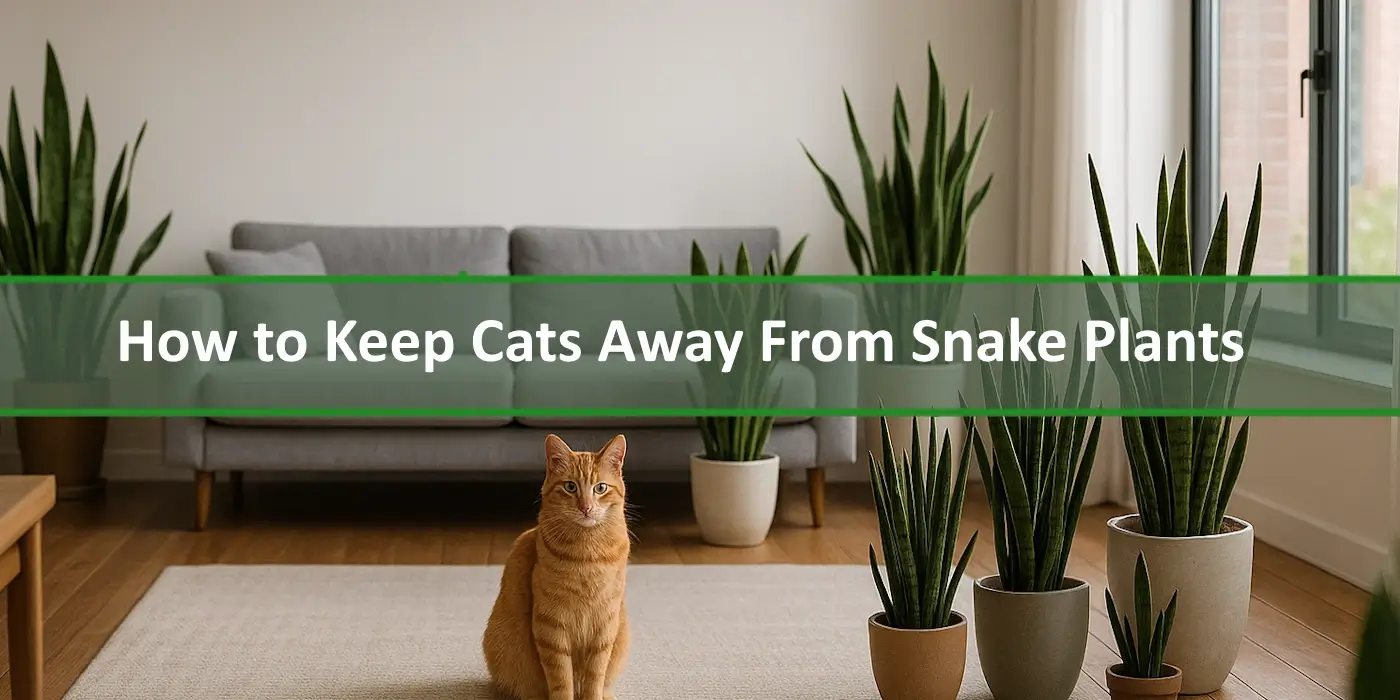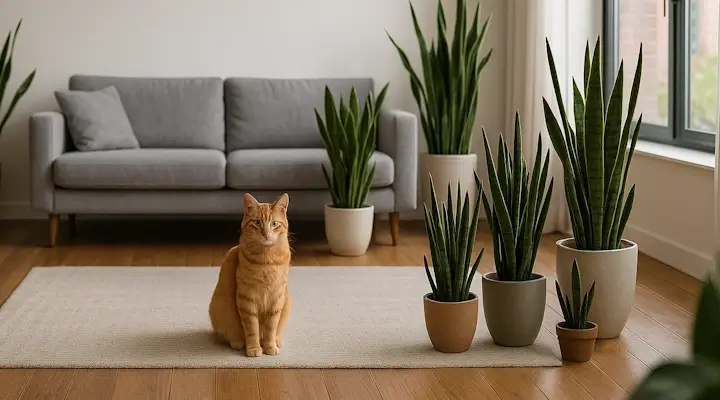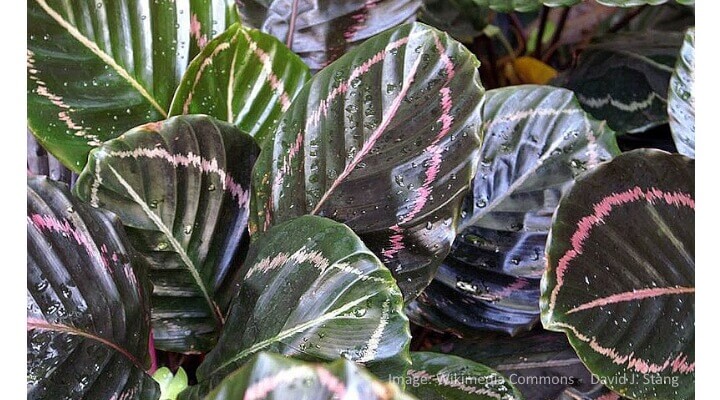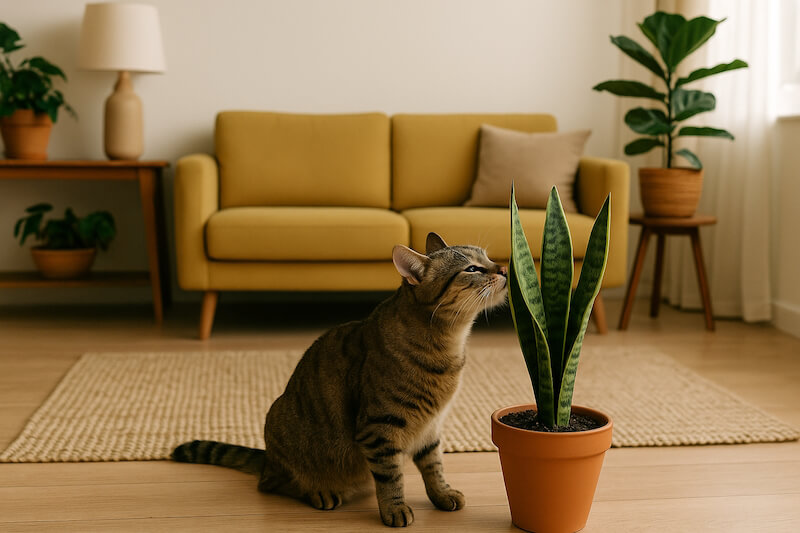
How to Keep Cats Away from Snake Plants (Safe Alternatives Too)

Trying to keep cats away from snake plants is easier said than done. You know how it is. You bring home a stunning Sansevieria cylindrica, place it on a shelf, and the next thing, your furry four-legged friend is circling like it’s prey. And the last thing you want is to come home to notice tiny bite marks on its leaves.
Table of Contents
That harmless-looking “mother-in-law’s tongue” isn’t so harmless. Snake plants contain compounds that can cause gastrointestinal distress. So keeping your feline buddy away from snake plants is vital. After all, no one wants their Mother-in-Law plant doubling as a vet bill.
So how do you protect both your houseplants and your pet, without turning your living room into a fortress?
I’ve put together this guide based on my own experience and reading countless blog posts and Reddit threads to find out the best methods of keeping pets, including cats, away from Sansevieria trifasciata plants. Interested in discovering top tips from plant experts? Read on to find out.
Why Cats Won’t Leave Snake Plants Alone
Ever wonder why your cat zeros in on snake plants like they’re the tastiest thing in the room? Those tall, sword-shaped leaves mimic outdoor grasses—exactly what cats chew to help their gastrointestinal tract. In other words, your indoor Sansevieria trifasciata looks like a giant snack bar.
Boredom doesn’t help. A cat stuck indoors without enough play might swat at leaves just for the thrill. And snake plants usually sit in low zones near the litter box or on the floor—prime feline hunting ground.

One Reddit user joked their cat ignored a whole jungle of indoor plants but launched a full-on assault on a single “mother-in-law’s tongue.” That’s the thing—cat behavior is unpredictable. Today they nap, tomorrow they’re chewing.
Add in the fact that snake plants grow upright, slow, and sturdy—like nature’s chew toy—and it’s no surprise cats keep coming back.
Curious how big these “chew toys” can actually get? Check out my guide on how big snake plants grow—it’ll give you a sense of why they’re such tempting targets for cats.
“I’ve grown more snake plants than I can count, and most issues boil down to the same basics. See my full snake plant care guide for the steps that actually work long-term.
Are Snake Plants Poisonous to Cats?
Yes, snake plants (also called mother-in-law’s tongue) contain compounds that can upset a cat’s gastrointestinal tract. Symptoms are usually mild but can still mean drooling, vomiting, or discomfort after a nibble.
If you want the complete breakdown of risks, symptoms, and what to do, check my detailed guide: Are Snake Plants Toxic to Cats?
Why People Love Snake Plants (and Why Cats Love Them Too)
Snake plants are one of the most popular indoor plants for good reason. They’re hardy, low-maintenance, and known for their air-purifying benefits. Research even highlights their role in filtering indoor pollutants while fitting seamlessly into modern design spaces.
The only drawback? Cats often see them as irresistible chew toys. That’s why a little extra effort in cat-proofing goes a long way.
Want more details on what makes them so special? I’ve covered the benefits of snake plants in depth.
Pet-Safe Deterrent Strategies to Keep Cats Away From Snake Plants
Keeping cats away from snake plants (and other houseplants) requires a multi-level approach. Think of it like building layers of defense. First—barriers to physically stop cats from getting close. Next, deterrents like DIY sprays with citrus oils. Finally, distractions. Think cat grass, a catnip plant, a scratching post, or non-toxic plants like prayer plants.

No matter your setup—tiny apartment, plant-packed living room, or curious kitten that treats your Sansevieria trifasciata like a chew toy—there’s a fix that works.
Physical Barriers That Work Indoors
Sometimes the easiest fix is keeping your cat from ever reaching the plant. These tricks block low zones and make snake plants less tempting.
- Floating shelves — lift your Sansevieria cylindrica out of reach without sacrificing décor.
- Hanging planters — macrame or ceiling hooks free up floor space and frustrate climbers.
- Plant cabinets — IKEA hacks or curio cabinets keep plants safe and stylish.
- Decorative screens — add privacy for your plants while upgrading the room vibe.
- Chicken wire or stones — Reddit users swear it stops digging, even if it looks rustic.
One Reddit user said chicken wire “looked awful but completely ended the digging.” Another shared that a tall cabinet was the only way to stop their cat’s midnight raids.

Want another bonus? Keeping plants out of reach not only protects them from chewing damage, it also prevents leaves from bending or sagging under stress. Here’s my guide on why snake plants droop.
Natural Deterrents for Indoor Plants
If barriers aren’t your style, make the plant itself less appealing. Use smells and textures cats hate but that won’t hurt them.
- Citrus rind — scatter orange or lemon peels on the potting soil.
- Double-sided tape — one Redditor said it was “the only thing that worked.”
- Pine cones — sharp edges make digging unpleasant.
- White vinegar spritz — dilute for a safe, nontoxic spray.
- Bitter apple spray — a classic pet-safe deterrent.
- DIY citrus oil spray — light, diluted, never straight essential oil.
One cat owner on Reddit said citrus peels “worked instantly until they dried out.” Another claimed sticky tape around the rim of the pot finally stopped the chewing. Many pet owners also claim that spinkling cayene pepper over the oil is the best way to keep all pets away from prized houseplants.
Want more pet-safe ideas? I’ve put together a complete guide on how to keep cats away from plants. There you’ll find a simple DIY spray recipe and what to avoid with citrus essential oil.
How to Keep Snake Plants Off Outdoor Plants
Outdoors, you need tougher defenses. Cats roam more freely, so combine deterrents with redirection.
- Motion-activated sprinklers — harmless but startling, great for garden patrol.
- Chicken wire or netting — circle the base to block chewing and digging.
- Diluted vinegar spray — reapply after rain for lasting deterrence.
- Sandbox or soil patch — give your cat a dedicated digging zone.
- Catnip plant corner — keep their attention away from your snake plant.
One Reddit gardener swore by motion sprinklers, saying, “It scared the cats but didn’t hurt them.”
Training and Distraction Tactics to Keep Cats Away From Houseplants
Long-term, training and redirection pay off. Give your cat better options than your Sansevieria trifasciata.
- Cat grass — the best chew alternative; Reddit users say it redirected behavior completely.
- Catnip plants — safe, fun, and irresistible.
- Chew toys — swap leaves for something designed to be bitten.
- Scratching posts — place near plants or litter box to draw energy away.
- Positive reinforcement — reward ignoring plants with treats or play.
One Reddit user said cat grass was a “game changer” that kept their plants safe. Another found their cat left the snake plant alone once a new scratching post was added near the window.
If your plant’s already sporting a few bite marks, don’t toss it. Snake plants are tough—you can start fresh by propagating healthy cuttings and keep your collection thriving.
Cat-Safe Alternatives to Snake Plants
You don’t have to give up greenery just because snake plants pose risks for cats. There are plenty of safe, stylish choices that keep your home looking vibrant without the stress. Think of it as swapping Sansevieria trifasciata for plants that love the spotlight just as much—minus the danger.
Easy-Care Safe Plants That Are Safe for Cats
Not every plant parent wants high-maintenance divas. Luckily, plenty of safe options are tough, forgiving, and cat-approved.

Here are some excellent non-toxic alternatives I’ve curated from the ASPCA if you can’t keep your cat away from snake plants.
- Spider plant — classic, cat-safe, and often called a “gateway plant.” One Redditor joked their cat “chews it like salad but never gets sick.”
- Prayer plant (Calathea, Maranta, Rattlesnake plant) — striking foliage, marantas are safe plants for cats, and loves the same indirect light as Sansevieria trifasciata.
- Peperomia obtusifolia — chunky, glossy leaves that look modern but won’t harm your furry friend.
- African violet — perfect for small pots, blooms add color without worry.
- Cat grass — the ultimate distraction plant. Reddit users say it completely redirected chewing habits away from toxic plants.
You can let your pet cat munch on these safe plants without worrying about gastrointestinal signs. One Reddit user laughed that their kitty treats spider plants “like salad leaves.”
Sure, plant parents might not love the ragged edges, but hey, at least there won’t be any vet bills hanging over your head.
Stylish Options That Mimic Snake Plant Vibes
Missing the tall, sculptural look of mother-in-law’s tongue? Try a Rattlesnake plant for vertical flair, or bold-leafed Calatheas for statement corners. One Reddit user said they swapped their Sansevieria cylindrica for clustered prayer plants and “never looked back.” These swaps bring the same aesthetic punch without the toxicity.
Cat-Proof Display Hacks
Sometimes the smartest move isn’t changing the plant—it’s changing how you display it.
Plant cabinets or greenhouse cabinets showcase greenery while keeping paws away. Floating shelves and macramé hangers raise plants out of reach. Soil diggers? Chicken wire, pine cones, or even tin foil keep claws at bay. A Reddit cat parent laughed that tin foil “looked ridiculous, but worked overnight.”
What To Do If Your Cat Licks a Snake Plant
First things first—don’t panic. A quick nibble on a snake plant usually causes mild stomach upset, but every cat reacts differently. Watch for signs like drooling, vomiting, or changes in appetite. If symptoms last, call your vet for advice.

I’ve covered the full step-by-step response (including when to contact the Pet Poison Helpline) in this detailed guide: What to do if your cat licks a snake plant.
Building a Cat-Safe Indoor Jungle
Creating a lush indoor jungle doesn’t mean choosing between your plants and your cat. With smart barriers, pet-safe deterrents, and swaps like prayer plants or Peperomia obtusifolia, you can have greenery and peace of mind.
Think layers: safe plants your cat can happily chew, statement plants displayed out of reach, and distractions like cat grass to redirect chewing habits. One Reddit user admitted their jungle only survived once they started “decorating for the cat as much as for me.”
Snake plants look incredible and bring air-purifying benefits, but they do require mindful cat-proofing. The good news? With the right setup, you’ll keep your Sansevieria trifasciata thriving and your feline happy, safe, and out of trouble.
Keeping Cats Away From Snake Plants: FAQs
Are snake plants poisonous to cats if they just lick them?
Yes, even a small lick can cause mild gastrointestinal signs like drooling or vomiting. For full details, see Are Snake Plants Toxic to Cats?.
What’s the safest way to keep cats out of houseplants?
Physical barriers (like floating shelves or plant cabinets) and pet-safe deterrents (such as citrus rind or pine cones) are the most effective ways.
What scent keeps cats away from plants?
Cats dislike citrus, vinegar, and bitter apple sprays. These scents are commonly used as natural deterrents, but always choose pet-safe, diluted options.
Is cat grass better than snake plants for cats to chew?
Yes, cat grass is completely safe and actually encourages healthy chewing behavior, unlike snake plants which contain calcium oxalate crystals.
Can motion-activated sprinklers keep cats away from outdoor snake plants?
Yes, sprinklers are one of the most effective outdoor cat deterrents because they startle without causing harm.
What indoor plants look like snake plants but are safe for cats?
Calathea, Rattlesnake plant, and Peperomia obtusifolia give a similar vibe without posing risks to your cat.
Will aluminum foil really keep cats out of plant pots?
Many cat parents say yes—cats dislike the texture and crinkle of tin foil, making it an easy soil deterrent.
How do I stop my cat from digging in plant soil?
Use pine cones, chicken wire, or decorative stones to block access. These options are safe, inexpensive, and widely recommended by pet owners.
Should I call the vet if my cat chewed a snake plant?
If your cat shows ongoing vomiting, lethargy, or loss of appetite, yes—call your vet. Mild cases may resolve on their own, but professional advice is safest.
Can cats be in the same room as a snake plant?
Yes, but only if the plant is placed out of reach. Hanging planters, floating shelves, or plant cabinets are smart setups that keep curious cats safe.
Do cats leave snake plants alone?
Not always. Some cats ignore them, but many are drawn to the leaves out of boredom or curiosity. It’s best to use deterrents or alternatives to prevent accidents.
Related Reading:
- Are Snake Plants Toxic to Cats? What to Do If Yours Ate One
- How Big Do Snake Plants Get?
- Why Is My Snake Plant Drooping?
- How to Keep Cats Away from Plants—Without Wrecking Your Indoor Jungle
- The Surprising Benefits of Snake Plants
- How to Propagate Snake Plants (Easy Methods That Work)
